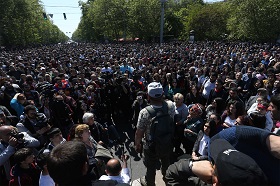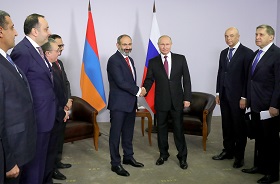Starting in April, 2018, Armenia witnessed a remarkable political revolution, prompted by Serzh Sargsyan’s attempt to remain in office by becoming the country’s Prime Minister. As massive crowds packed Yerevan’s Republic Square, the veteran Armenian politician ultimately bowed to popular pressure and stepped aside on April 23. The second phase of the April Revolution saw the ascendancy of protest leader Nikol Pashinyan to the Prime Minister’s office. Pashinyan’s proposed electoral reform promises to pave the way for a more competitive political system in Armenia, breaking the monopoly of the ruling Republican Party, which has dominated Armenian politics since the late 1990s.
Even more remarkable was the lack of any foreign involvement in the April Revolution. There were no “little green men” in the Ararat valley, nor was America’s Victoria Nuland on hand to pass out cookies on Republic Square. In reality, the involvement of United States was nonexistent, while the role of Russia was minimal, although not insignificant. In contrast to the reaction to the Electric Yerevan protests in 2015, there was no rush in the Russian media or among Russian political elites to draw parallels with the Ukrainian Maidan or the “color revolutions.” Instead, Moscow was cautious and pragmatic, emphasizing the necessity of a legal transition of power. Publicly, Russian Foreign Ministry spokeswoman Maria Zakharova even supported the demonstrators, writing “Armenia, Russia is always with you!”
Starting in April, 2018, Armenia witnessed a remarkable political revolution, prompted by Serzh Sargsyan’s attempt to remain in office by becoming the country’s Prime Minister. As massive crowds packed Yerevan’s Republic Square, the veteran Armenian politician ultimately bowed to popular pressure and stepped aside on April 23. The second phase of the April Revolution saw the ascendancy of protest leader Nikol Pashinyan to the Prime Minister’s office. Pashinyan’s proposed electoral reform promises to pave the way for a more competitive political system in Armenia, breaking the monopoly of the ruling Republican Party, which has dominated Armenian politics since the late 1990s.
Even more remarkable was the lack of any foreign involvement in the April Revolution. There were no “little green men” in the Ararat valley, nor was America’s Victoria Nuland on hand to pass out cookies on Republic Square. In reality, the involvement of United States was nonexistent, while the role of Russia was minimal, although not insignificant. In contrast to the reaction to the Electric Yerevan protests in 2015, there was no rush in the Russian media or among Russian political elites to draw parallels with the Ukrainian Maidan or the “color revolutions.” Instead, Moscow was cautious and pragmatic, emphasizing the necessity of a legal transition of power. Publicly, Russian Foreign Ministry spokeswoman Maria Zakharova even supported the demonstrators, writing “Armenia, Russia is always with you!”
Two-sided nature of the Russia-Armenia relations
The Russia-Armenia relationship is two-sided. For Armenia, Russia means protection from neighboring Azerbaijan and Turkey. For Russia, Armenia represents an important ally in the Caucasus, a region critical to Russian security concerns. Therefore, Russia observed the recent developments in Armenia very closely. Behind the scenes, Russian officials were in contact with both sides in order to gain a clear understanding of the events. According to protest leader Armen Grigoryan and certain unnamed sources, the opposition emphasized to Russian officials that the protest was strictly domestic and was not directed in any way against Russia. This message was further emphasized by Pashinyan to the delegation of Russian Duma deputies who visited Yerevan. Not only were Russia-Armenia relations under no threat, but they would be “deepened” should Pashinyan become Prime Minister. The protest leaders also made an effort to ensure that no EU or American flags were flown during the Armenian protest.
Russian officials were also in contact with representative of the Armenian government and the ruling party. In the early days of the protest, it became clear to Moscow that Serzh Sargsyan had no political future. His decision to remain in power was a major misstep in the Armenian context, and therefore supporting him would be a liability for the Russian side. However, in terms of his successor, Moscow was initially more inclined to support acting Prime Minister Karen Karapetyan. A reform-minded politician, Karapetyan governed Armenia from the Prime Minister post effectively for a year and a half, although the Republican Party machine prevented him from making major changes. The former chief executive of ArmRosGazprom, he also has good business and political contacts with Russia, including with Prime Minister Dmitry Medvedev and Russian-Armenian billionaire Samvel Karapetyan (no relation to Karen). Therefore, he represented both stability and change to Moscow.
However, it soon became clear that the protestors in Yerevan wanted to abolish the ruling Republican Party machine entirely. Although Sargsyan’s bid to stay in power served as the immediate motivation for the protests, the causes – chiefly jobs and economic inequality – were much deeper. Fundamental changes were required to remedy them. In this case, Pashinyan’s bid, to both become interim Prime Minister and to reform the electoral laws, represented a better alternative for the demonstrators. Gradual reform of the existing system was no longer a tenable option. Therefore, Moscow remained neutral, while Karapetyan rejected the offer to become the Prime Minister candidate of the Republican Party, leaving the ruling party with no candidate to nominate.
Putin-Pashinyan personal chemistry
The situation was reinforced by Pashinyan’s meeting with the Duma MPs on April 29, which cleared the way for his eventual victory on May 8. Notably, after Pashinyan’s election as Prime Minister, Vladimir Putin was one of the first political leaders to congratulate him. Later, in a phone conversation with Putin, Pashinyan exchanged greetings with him on the occasion of Victory Day, commemorating the Soviet defeat of Nazi Germany in World War II. Notably, Pashinyan’s grandfather and namesake, Nikolai, fought in the Red Army and died in the war. The new Armenian PM also reaffirmed Armenia’s commitment to the Eurasian Economic Union, the Commonwealth of Independent States (CIS), and the Collective Security Treaty Organization (CSTO). However, within the context of the Eurasian Economic Union, he may push for a more democratic and egalitarian relationship among the member states to ensure that smaller republics, like Armenia, will have more of a say in determining the policy of the union.
On May 14, Pashinyan and Putin met in Sochi where they had very positive and constructive talks. In the meeting, Putin hailed Armenia as a “close ally and partner in the region.” For his part, Pashinyan assured Putin that “there is a consensus in Armenia: no one has ever questioned the strategic importance of the Armenian-Russian relations, and I think it will not be questioned ahead.” He also met with Eurasian Union Chairman and former Armenian PM Tigran Sargsyan and held a rally with the Armenian community of Sochi.
Why Armenia’s opposition shied away from anti-Russian rhetoric
While Russia exercised incredible restraint in reaction to the April Revolution, the leaders of the revolt also learned valuable lessons about Russia-Armenia relations and the potentially adverse impact of their past anti-Russian statements. Given the extraordinary importance of the Russia-Armenia relationship, most Armenian politicians across party lines traditionally understood that Russophobia was counter-productive for the country. However, in recent years, some Armenian opposition leaders, taking cues from developments in Ukraine and Georgia, began to incorporate such discourse into their attacks on the government. Although Pashinyan has never been known to be exceptionally anti-Russian, even he adopted this position in his criticism of the Eurasian Economic Union.
In one way, anti-Russian rhetoric was useful for both the Armenian government and the opposition, to alert Russia that it could not take Armenia for granted. However, the April Revolution demonstrated that Armenian Russophobia could also be fatal for the opposition. Amid their stunning success, it soon became clear that anti-Russian policy was in fact hindering their far more important objectives (e.g., challenging the Republican Party monopoly). Consequently, Pashinyan moved quickly to reassure the Russian press and the Russian political elite that the revolution was not directed in any way against Moscow.
Meanwhile intending to capitalize on Pashinyan’s past remarks, the ruling party attempted to paint the revolutionary leader as a reckless Russophobe for both Russian observers and Armenia’s domestic audience. In the end, they failed to convince these two audiences, both of whom gave Pashinyan the benefit of the doubt. However, it was a close call for Pashinyan and it clearly illustrated the pitfalls of unnecessary anti-Russian bluster in Armenia.
Alternative path
Not only is anti-Russian discourse counter-productive in terms of its immediate political impact, but also in terms of its broader relevance. The April Revolution in Armenia has regional and even global significance that the Rose or Orange Revolutions or the Maidan would never attain since they allowed themselves to be blinded by the allure of geopolitics and national chauvinism. Shifting away from the geopolitical context, the revolution in Armenia presents an alternative path for the post-Soviet states. Instead of excluding Russia and casting it as an “eternal enemy,” why not include it in broader regional discussions about democracy, economic justice, and state-building?
Although each former Soviet republic is unique, they all share broadly similar socioeconomic problems as well as the common historical and cultural experiences of Imperial Russia and the USSR. In an age of globalization, these commonalities are the foundation for greater regional cooperation. Therefore, maintaining broad transnational cultural and economic connections across the post-Soviet space is an asset for all. The April Revolution in Armenia is significant as is a civic movement that realizes such potential.






